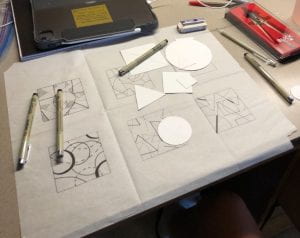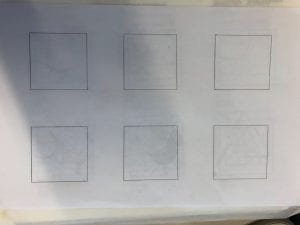Research
None
Exercises/ Activities
A2 Exercise
For this exercise, we used our square templates and traced circles, triangles, and squares of various sizes to show different design principles. I liked this exercise because I got to play around with line weight and empty space and I really bent the rules to make it how I wanted it to look. I played with the lines mostly by dotting them or not finished the whole shape, creating a straight line.
Point Line Plane Exercise
The goal for this exercise was to convey specific design principles using only a point, line, and plane. The constrictions were that 2 of your shapes had to be static and the other 2 dynamic, and each shape had to be convex, using protrusions instead of intrusions to construct the shape. Half of each composition had to be curvilinear and the other half geometric. We had 4 8x8in squares in white card stock and our point, line, and plane was cut out of black card stock to promote contrast.
Iterations
The process of making the 3×3 square template was very meticulous.
The process of A2 exercise was a challenge because I used circles when we supposed to only use pointed geometrical shapes for tracing. I also had trouble visualizing the hidden shapes.

My first attempt at shape, line, plane compositions was a bit of a flop. I didn’t understand the directions and used the wrong type of shapes, and they looked very boring and blob-like.
My second attempt was much better, where I replaced the worst 2 compositions with better ones that followed the criteria.
My first idea for final project looks good at first but it was too complicated to continue with.
My final project idea was amazing in my eyes, I like how abstracted it is while still giving off strong elements and principle.
Production
One of the most important starting pieces for this project was the 6 panel tracing paper. Deb specified that if the lines were even 1 cm off then we would get points off. I had trouble with the precise measurements but with practice, I got it down. It took a couple of tries and erased and an explanation as to why it was so important until I understood completely. If this version wasn’t perfect, then all the tracing would be imperfect too.
With the first assignment, A2, I really enjoyed how much freedom I had in arranging my shapes and the different kinds of outlines I could use. My thought was that I got bored with the usual process, like drawing solid lines, so I spiced it up a bit and made it my own work.
 I began with the dotted lines, then tried playing with the line weight and even the negative space combined with line weight. When I first started changing things, I was afraid that I would get scolded for breaking instructions but I learned that here, there are no incorrect answers or actions. I had a lot of fun trying out new outlines and designs between the shapes.
I began with the dotted lines, then tried playing with the line weight and even the negative space combined with line weight. When I first started changing things, I was afraid that I would get scolded for breaking instructions but I learned that here, there are no incorrect answers or actions. I had a lot of fun trying out new outlines and designs between the shapes.
I think it turned out well and Deb agree because she complimented me the next day. I learned from this that its ok to be bored sometimes, beneficial even, because it allows you to think outside the box and experiment. If I had to do this again, I might have made my shapes in different sizes so I would have more range and scale to play with, as my shapes were similar in size.
With the second part of the A2 assignment, filling in spaces to make new shapes, I struggled a bit. The objective was to find new shapes inside our other shapes, through the overlaps and edges. My trouble with this was that Deb wanted us to start with geometric shapes, all corners and not curves, but since I worked with circles in almost every piece, it was hard to find straight shapes. Maybe next time I will do pieces with only one shape instead of all three all the time.
For the shape line plane exercises, I didn’t give the initial project much thought and just threw together my original 4 compositions. I didn’t fully understand the instructions, so I didn’t realize that the two curvilinear shapes and the two geometric shapes had to be the same. I corrected this mistake later because first attempts are never the best. For the given principles, I went with the obvious choice: movement for the dynamic pieces, and harmony for the static pieces.
The second take gave me an opportunity to redo 2 of my compositions. Deb gave me some good feedback and told me to explore more with the line and how it didn’t necessarily have to be straight in the curvilinear pieces. I took it one step further and starting thinking about the point in this respect too. From that, I created my dripping piece by stretching and bending the line and point in one joint fluid motion. For my second replacement piece, I just made it more obviously a dynamic piece and changed the scale of my shape. I wanted to convey the action of sliding so I positioned my shape at an angle on the page and placed the line underneath it, as a ground line. I wanted to show that gravity was in effect and the shape was in a state of movement as it slide down the line. For the dot, I just placed it above the shape, almost making it look like a person. I accepted the final piece but it wasn’t as attractive to me as the other composition.
 For the actual final piece, I started with this crazy shape. Right after it was made, I realized that it was way too complicated and they wasn’t really a strong design principle that connected to it.
For the actual final piece, I started with this crazy shape. Right after it was made, I realized that it was way too complicated and they wasn’t really a strong design principle that connected to it.
For my second attempt, I decided to start with a design principle and brainstorm from there, which I found to be much easier. I decided on harmony/ symmetry and built a compositions using all 3 shapes. I wanted my piece to be symmetrical because symmetry looks very smooth to me and calming. Earlier in this project I was digitally playing with my shapes, trying to create new shapes(as you can see in my first attempt of the final) and I accidentally made a raindrop. Its not a new shape but I really liked it and wanted to use it in this final composition. I paired that underneath my main square in the center of the paper, again promoting symmetry. When I compared my piece to my classmates pieces, mine looks very different and plain when seen next to big, bubbly, extravagant shapes. But, I followed my plan and my vision to what I planned for my piece to be.








